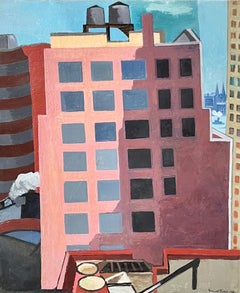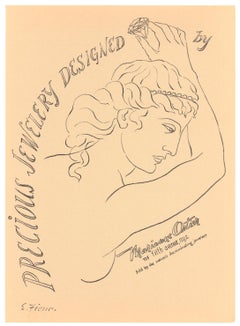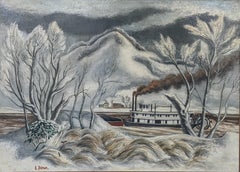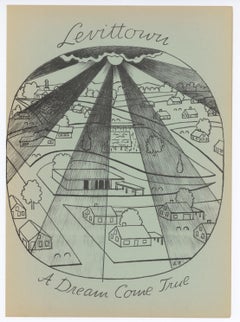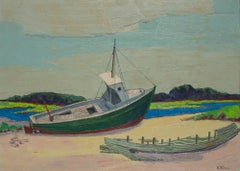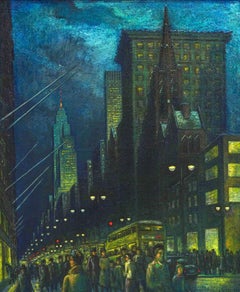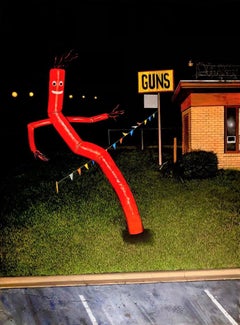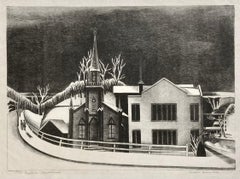Ernest Fiene Art
to
2
10
10
9
4
3
1
NYC Cityscape American Scene WPA Modern Realism Mid 20th Century Architectural
By Ernest Fiene
Located in New York, NY
NYC Cityscape American Scene WPA Modern Realism Mid 20th Century Architectural
Ernest Fiene (1894-1965)
Cityscape
36 x 30 inches
Oil on canvas
Signed and dated 1930. lower right
Provenance
Estate of the artist.
ACA Galleries, New York
Exhibited
New York, Frank Rehn Gallery, Changing Old New York, 1931.
New York, ACA Galleries, Ernest Fiene: Art of the City, 1925-1955, May 2-23, 1981, n.p., no. 5.
BIO
Ernest Fiene was born in Elberfeld, Germany in 1894. As a teenager, Fiene immigrated to the United States in 1912. He studied art at the National Academy of Design in New York City from 1914 to 1918, taking day classes with Thomas Maynard and evening classes with Leon Kroll. Fiene continued his studies at the Beaux-Arts Institute of Design in New York from 1916 to 1918, adding classes in printmaking at the Art Students League in 1923.
Fiene began his career as an artist in 1919 with his first exhibition of watercolors at the MacDowell Club arranged by his mentor Robert Henri. In 1923 the Whitney Studio Club mounted a large exhibition of his works. The following year he had an exhibition at the New Gallery in New York, which completely sold out all fifty-two works, including paintings, watercolors, drawings, and etchings. With the proceeds of sales from the New Gallery exhibition, Ernest Fiene and his younger brother Paul, a sculptor, built studios in Woodstock, New York in 1925.
In the early Twenties Ernest Fiene painted mostly landscapes of Woodstock and both the Ramapo and Hudson River Valleys. The first monograph from the Younger Artists Series was published on Fiene in 1922. Published in Woodstock, the series went on to include Alexander Brook, Peggy Bacon, and Yasuo Kuniyoshi. The book reproduced 1 illustration in color and another 27 reproductions in black and white. Around 1925 Fiene became fascinated with the intensity, excitement, and opportunities for color harmonies New York City offered as a subject. His paintings shifted to urban and industrial themes with architecture, industry, and transportation becoming his subjects.
By 1926 Fiene had attracted the dealer Frank K.M. Rehn, who gave him a one-man exhibition that year, which travelled to the Boston Arts Club. C.W. Kraushaar Galleries gave Fiene a one-man exhibition of urban, landscape, portrait, and still life paintings in 1927. Julianna Force, the director of the Whitney Studio Club and first director of the Whitney Museum of American Art, included two of Fiene’s paintings in a fall exhibition in 1928. The Whitney Studio Club showed Fiene’s paintings in a two-man exhibition with Glenn O. Coleman that year and acquired three of Fiene’s paintings. Also in 1928 Fiene became affiliated with Edith Halpert’s Downtown Gallery where he had an exhibition of 20 lithographs in the spring. Fiene sold his house in Woodstock in 1928 to spend more of his time in New York City.
With so many successful exhibitions, Fiene returned to Paris in 1928-29 where he rented Jules Pascin's studio and studied at the Académie de la Grande Chaumière. In France, Fiene painted both landscape and urban subjects developed from ideas influenced by Cubist geometry and the use of flat areas of broad color. Upon returning to New York in 1930, Fiene used this new approach to continue to paint New York skyscraper and waterfront subjects, as well as to begin a series of paintings on changing old New York based on the excavations for Radio City Music Hall and the construction of the Empire State Building. Frank K.M. Rehn Galleries exhibited this series, titled “Changing Old New York,” in 1931. Fiene also has solo exhibitions at Rehn Galleries in 1930 and 1932. Fiene’s oil paintings are exhibited at the Chicago Arts Club in 1930 as well.
Fiene was included in the Museum of Modern Art’s exhibition Painting and Sculpture by Living Americans in December of 1931. Visiting New York, Henri Matisse saw the exhibition and called Fiene’s Razing Buildings, West 49th Street the finest painting he had seen in New York. Fiene had two mural studies from his Mechanical Progress series exhibited at the Museum of Modern Art’s exhibition Murals by American Painters and Photographers in 1932. Fiene sent View from my Window which depicts Fiene working on a lithograph stone while looking out his window to the newly completed Empire State Building to the Carnegie International in 1931. In 1932 Fiene participated in the first Biennial of American Painting at the Whitney Museum and his prints were included in exhibitions at the Downtown Gallery and the Wehye Gallery. In the same year, Fiene was awarded a Guggenheim fellowship to further study mural painting in Florence, Italy.
On his return from Italy in 1933 Fiene re-engaged himself in New York City life and won several public and private mural projects. Fiene resumed his active exhibition schedule, participating in two group exhibitions at the Whitney Museum and a one-man exhibition of recent paintings at the Downtown Gallery in January 1934. In 1933 he purchased a farm in Southbury, Connecticut, which added Connecticut scenes to his landscape subjects. This was also the year Fiene began to spend summers on Monhegan Island, Maine, where he painted seascapes, harbor scenes, and still lifes.
Fiene’s landscape paintings attracted numerous commissions as part of the American Scene movement. Through the fall and winter of 1935-36, Fiene took an extended sketching trip through the urban, industrial, and farming areas of Pennsylvania and West Virginia. Most of the twenty-four Pennsylvania urban and rural paintings...
Category
1930s American Modern Ernest Fiene Art
Materials
Canvas, Oil
original lithograph
By Ernest Fiene
Located in Henderson, NV
Medium: original lithograph. This lithograph is from the rare 1953 "Improvisations" portfolio, published by the Artists Equity Association of New York on the occasion of the 1953 Spr...
Category
1950s Ernest Fiene Art
Materials
Lithograph
"Along the Kanahawa River, West Virginia, " Ernest Fiene, WPA Coal Steamboat
By Ernest Fiene
Located in New York, NY
Ernest Fiene
Along the Kanahawa River, West Virginia, 1936
Signed lower right
Oil on canvas
26 x 36 inches
Fiene made a series of paintings, drawings and lithographs which are based on his travels through Pennsylvania and West Virginia during the winter of 1935-36. The industrial areas of Pennsylvania and West Virginia are represented in numerous oils, among which are some of his most well-known. Fiene wrote of the trip, "The increasing snow and atmospheric conditions [in the Kanawha River valley} enhanced this mountainous coal mining country with a majestic beauty."
Winter on the River is Fiene's only American Artists Group print and there were only two lithographs produced from the West Virginia trip. The American Artists Group (AAG), under the direction of Carl Zigrosser, who was then working at New York's famed Weyhe Gallery, published ninety-three prints by over fifty artists in 1936 and 1937. Zigrosser's goal was to popularize contemporary American art through original prints offered at the low price of $2.75. The project was also a means to provide income for impoverished artists during the Depression. The prints were featured in many of the leading print exhibitions and publications of the period. The lithograph produced from this image is now in the collection of the Amon Carter Museum, Baltimore Museum of Art, Cleveland Museum of Art, Philadelphia Museum of Art, Pensacola Museum of Art, San Francisco Fine Arts Museum, Syracuse Museum, Yale University Art Museum.
Ernest Fiene was born in Elberfeld, Germany in 1894. As a teenager, Fiene immigrated to the United States in 1912. He studied art at the National Academy of Design in New York City from 1914 to 1918, taking day classes with Thomas Maynard and evening classes with Leon Kroll. Fiene continued his studies at the Beaux-Arts Institute of Design in New York from 1916 to 1918, adding classes in printmaking at the Art Students League in 1923.
Fiene began his career as an artist in 1919 with his first exhibition of watercolors at the MacDowell Club arranged by his mentor Robert Henri. In 1923 the Whitney Studio Club mounted a large exhibition of his works. The following year he had an exhibition at the New Gallery in New York, which completely sold out all fifty-two works, including paintings, watercolors, drawings, and etchings. With the proceeds of sales from the New Gallery exhibition, Ernest Fiene and his younger brother Paul, a sculptor, built studios in Woodstock, New York in 1925.
In the early Twenties Ernest Fiene painted mostly landscapes of Woodstock and both the Ramapo and Hudson River Valleys. The first monograph from the Younger Artists Series was published on Fiene in 1922. Published in Woodstock, the series went on to include Alexander Brook, Peggy Bacon, and Yasuo Kuniyoshi. The book reproduced 1 illustration in color and another 27 reproductions in black and white. Around 1925 Fiene became fascinated with the intensity, excitement, and opportunities for color harmonies New York City offered as a subject. His paintings shifted to urban and industrial themes with architecture, industry, and transportation becoming his subjects.
By 1926 Fiene had attracted the dealer Frank K.M. Rehn, who gave him a one-man exhibition that year, which travelled to the Boston Arts Club. C.W. Kraushaar Galleries gave Fiene a one-man exhibition of urban, landscape, portrait, and still life paintings in 1927. Julianna Force, the director of the Whitney Studio Club and first director of the Whitney Museum of American Art, included two of Fiene’s paintings in a fall exhibition in 1928. The Whitney Studio Club showed Fiene’s paintings in a two-man exhibition with Glenn O. Coleman that year and acquired three of Fiene’s paintings. Also in 1928 Fiene became affiliated with Edith Halpert’s Downtown Gallery where he had an exhibition of 20 lithographs in the spring. Fiene sold his house in Woodstock in 1928 to spend more of his time in New York City.
With so many successful exhibitions, Fiene returned to Paris in 1928-29 where he rented Jules Pascin's studio and studied at the Académie de la Grande Chaumière. In France, Fiene painted both landscape and urban subjects developed from ideas influenced by Cubist geometry and the use of flat areas of broad color. Upon returning to New York in 1930, Fiene used this new approach to continue to paint New York skyscraper and waterfront subjects, as well as to begin a series of paintings on changing old New York based on the excavations for Radio City Music Hall and the construction of the Empire State Building. Frank K.M. Rehn Galleries exhibited this series, titled “Changing Old New York,” in 1931. Fiene also has solo exhibitions at Rehn Galleries in 1930 and 1932. Fiene’s oil paintings are exhibited at the Chicago Arts Club in 1930 as well.
Fiene was included in the Museum of Modern Art’s exhibition Painting and Sculpture by Living Americans in December of 1931. Visiting New York, Henri Matisse saw the exhibition and called Fiene’s Razing Buildings, West 49th Street the finest painting he had seen in New York. Fiene had two mural studies from his Mechanical Progress series exhibited at the Museum of Modern Art’s exhibition Murals by American Painters and Photographers in 1932. Fiene sent View from my Window which depicts Fiene working on a lithograph stone while looking out his window to the newly completed Empire State Building to the Carnegie International in 1931. In 1932 Fiene participated in the first Biennial of American Painting at the Whitney Museum and his prints were included in exhibitions at the Downtown Gallery and the Wehye Gallery. In the same year, Fiene was awarded a Guggenheim fellowship to further study mural painting in Florence, Italy.
On his return from Italy in 1933 Fiene re-engaged himself in New York City life and won several public and private mural projects. Fiene resumed his active exhibition schedule, participating in two group exhibitions at the Whitney Museum and a one-man exhibition of recent paintings at the Downtown Gallery in January 1934. In 1933 he purchased a farm in Southbury, Connecticut, which added Connecticut scenes to his landscape subjects. This was also the year Fiene began to spend summers on Monhegan Island, Maine, where he painted seascapes, harbor scenes, and still lifes.
Fiene’s landscape paintings attracted numerous commissions as part of the American Scene movement. Through the fall and winter of 1935-36, Fiene took an extended sketching trip through the urban, industrial, and farming areas of Pennsylvania and West Virginia. Most of the twenty-four Pennsylvania urban and rural paintings from this trip were featured in an exhibition held at the First National Bank in Pittsburgh in October of 1937 by the Pittsburgh Commission for Industrial Expansion. Fiene said of these works that he formed rhythm, opportunity for space and color, and integrity in the Pennsylvania mill and furnace paintings. Fiene received the silver medal for one of the Pittsburgh paintings...
Category
1930s American Realist Ernest Fiene Art
Materials
Canvas, Oil
original lithograph
By Ernest Fiene
Located in Henderson, NV
Medium: original lithograph. This lithograph is from the rare 1952 "Improvisations" portfolio, published by the Artists Equity Association of New York on the occasion of the 1952 Spr...
Category
1950s Ernest Fiene Art
Materials
Lithograph
"Low Tide at Noon, Wellfleet, Massachusetts, " Ernest Fiene, WPA, Boat on Beach
By Ernest Fiene
Located in New York, NY
Ernest Fiene (1894 - 1965)
Low Tide at Noon, Wellfleet, Massachusetts
Oil on canvas
26 x 36 inches
Signed lower right
Ernest Fiene was born in Elberfeld, Germany in 1894. As a teenager, Fiene immigrated to the United States in 1912. He studied art at the National Academy of Design in New York City from 1914 to 1918, taking day classes with Thomas Maynard and evening classes with Leon Kroll. Fiene continued his studies at the Beaux-Arts Institute of Design in Paris from 1916 to 1918, adding classes in printmaking at the Art Students League in 1923.
Fiene began his career as an artist in 1919 with his first exhibition of watercolors at the MacDowell Club arranged by his mentor Robert Henri. In 1923 the Whitney Studio Club mounted a large exhibition of his works. The following year he had an exhibition at the New Gallery in New York, which completely sold out all fifty-two works, including paintings, watercolors, drawings, and etchings. With the proceeds of sales from the New Gallery exhibition, Ernest Fiene and his younger brother Paul, a sculptor, built studios in Woodstock, New York in 1925.
In the early Twenties Ernest Fiene painted mostly landscapes of Woodstock and both the Ramapo and Hudson River Valleys. He was the subject of the first monograph for the Younger Artists Series in 1922. Published in Woodstock, the series went on to include Alexander Brook, Peggy Bacon, and Yasuo Kuniyoshi. The book reproduced 1 illustration in color and another 27 reproductions in black and white. Around 1925 Fiene became fascinated with the intensity, excitement, and opportunities for color harmonies New York City offered as a subject. His paintings shifted to urban and industrial themes with architecture, industry, and transportation becoming his subjects.
By 1926 Fiene had attracted the dealer Frank K.M. Rehn, who gave him a one-man exhibition that year, which travelled to the Boston Arts Club. C.W. Kraushaar Galleries gave Fiene a one-man exhibition of urban, landscape, portrait, and still life paintings in 1927. Julianna Force, the director of the Whitney Studio Club and first director of the Whitney Museum of American Art, included two of Fiene's paintings in a fall exhibition in 1928. The Whitney Studio Club showed Fiene's paintings in a two-man exhibition with Glenn O. Coleman that year and acquired three of Fiene's paintings. Also in 1928 Fiene became affiliated with Edith Halpert's Downtown Gallery where he had an exhibition of 20 lithographs in the spring. Fiene sold his house in Woodstock in 1928 to spend more of his time in New York City.
With so many successful exhibitions, Fiene returned to Paris in 1928-29 where he rented Jules Pascin's studio and studied at the Académie de la Grande Chaumière. In France, Fiene painted both landscape and urban subjects developed from ideas influenced by Cubist geometry and the use of flat areas of broad color. Upon returning to New York in 1930, Fiene used this new approach to continue to paint New York skyscraper and waterfront subjects, as well as to begin a series of paintings on changing old New York based on the excavations for Radio City Music Hall and the construction of the Empire State Building. Frank K.M. Rehn Galleries exhibited this series, titled "Changing Old New York," in 1931. Fiene also has solo exhibitions at Rehn Galleries in 1930 and 1932. Fiene's oil paintings are exhibited at the Chicago Arts Club in 1930 as well.
Fiene was included in the Museum of Modern Art's exhibition Painting and Sculpture by Living Americans in December of 1931. Visiting New York, Henri Matisse saw the exhibition and called Fiene's Razing Buildings, West 49th Street the finest painting he had seen in New York. Fiene had two mural studies from his Mechanical Progress series exhibited at the Museum of Modern Art's exhibition Murals by American Painters and Photographers in 1932. Fiene sent View from my Window which depicts Fiene working on a lithograph stone while looking out his window to the newly completed Empire State Building to the Carnegie International in 1931. In 1932 Fiene participated in the first Biennial of American Painting at the Whitney Museum and his prints were included in exhibitions at the Downtown Gallery and the Wehye Gallery. In the same year, Fiene was awarded a Guggenheim fellowship to further study mural painting in Florence, Italy.
On his return from Italy in 1933 Fiene re-engaged himself in New York City life and won several public and private mural projects. Fiene resumed his active exhibition schedule, participating in two group exhibitions at the Whitney Museum and a one-man exhibition of recent paintings at the Downtown Gallery in January 1934. In 1933 he purchased a farm in Southbury, Connecticut, which added Connecticut scenes to his landscape subjects. This was also the year Fiene began to spend summers on Monhegan Island, Maine, where he painted seascapes, harbor scenes, and still lifes.
Fiene's landscape paintings attracted numerous commissions as part of the American Scene movement. From 1935-36 Fiene took an extended sketching trip through the urban, industrial, and farming areas of Pennsylvania and West Virginia. Most of the twenty-four Pennsylvania urban and rural paintings from this trip were featured in an exhibition held at the First National Bank in Pittsburgh in October of 1937 by the Pittsburgh Commission for Industrial Expansion. Fiene said of these works that he formed rhythm, opportunity for space and color, and integrity in the Pennsylvania mill and furnace paintings. Fiene received the silver medal for one of the Pittsburgh paintings...
Category
Mid-20th Century American Realist Ernest Fiene Art
Materials
Canvas, Oil
Winter Evening Fifth Avenue - New York at Night - Mid-Century.
By Ernest Fiene
Located in Miami, FL
Mid-century New York City is represented as a moment in time. The artist populates his scene with isolated figures that are more shapes of people as opposed to specific individuals....
Category
1950s Post-Impressionist Ernest Fiene Art
Materials
Canvas, Oil
Winter Evening Fifth Avenue - New York at Night
By Ernest Fiene
Located in Miami, FL
Ernest Fiene depicts Fifth Avenue looking down from 57th Street with an unobstructed view of the Empire State Building. The absence of newer glass and steel architecture gives the painting the charm of old New York. The artist captures a dark, moody blue sky as light bounces back from the clouds. This contrasts with the somewhat haunting yellow glow given to pedestrians and street traffic. The people have somewhat of a zombie quality akin to George Tooker. Best viewed with a top and direct gallery light...
Category
1950s Post-Impressionist Ernest Fiene Art
Materials
Oil, Canvas
Thistles with Greek Relief
By Ernest Fiene
Located in Boston, MA
Ernest Fiene, American (1894-1965), Thistles with Greek Relief, 1948
Signed lower right: "E. Fiene". Titled and signed on stretcher: "Thistles with Gree...
Category
1940s Realist Ernest Fiene Art
Materials
Oil
Ernest Fiene, Connecticut Village Landscape, Oil Painting, circa 1921
By Ernest Fiene
Located in New York, NY
Signed by the artist and dated 1921 in the front lower right corner, this oil on board painting, in all probability, depicts a small Connecticut village by a lake.
Ernest Fiene (18...
Category
20th Century American Other Ernest Fiene Art
Materials
Paint
Phlox Flower Still Life Oil Painting Antique Exhibited Large Framed Oil Painting
By Ernest Fiene
Located in Buffalo, NY
Antique oil on canvas by Ernest Fiene (1894 - 1965) . This work was exhibited at Midtown Galleries. Housed in its original modernist frame as well. Perfect and ready to hang! Tit...
Category
1930s Modern Ernest Fiene Art
Materials
Canvas, Oil
Related Items
Contemporary, Dark, American Oil Painting on Canvas
Located in Fort Worth, TX
GUN SALE is an oil on canvas painting standing at 54 inches tall and 41 inches wide, featuring an inflatable advertiser standing adjacent to a gunshop seated in a dark, night sky background.
A well-known figure of the contemporary Fort Worth art scene, Daniel Blagg...
Category
2010s American Realist Ernest Fiene Art
Materials
Canvas, Oil
Large, Retro, Oil Painting on Canvas
Located in Fort Worth, TX
Daffodil, Daniel Blagg, Oil on Canvas, 42 x 54", 2019
A well-known figure of the contemporary Fort Worth art scene, Daniel Blagg has worked in the DFW ar...
Category
2010s American Realist Ernest Fiene Art
Materials
Canvas, Oil
Tempête à Honfleur
Located in LE HAVRE, FR
Lyne SEYBEL (1919-2009)
Tempête à Honfleur
Oil on canvas
Size: 65 x 92 cm
Signed lower left.
In perfect state of conservation.
With beautiful frame
Provenance: Family of the artist...
Category
1960s Post-Impressionist Ernest Fiene Art
Materials
Oil, Canvas
Barque At Sea, Woollahra
Located in London, GB
Signed, title on the overlap,
Depicting a sailing vessel at sea, amidst choppy waves.
In a modern frame.
Good condition, yellow varnish to the bottom left corner of the frame
Category
21st Century and Contemporary American Realist Ernest Fiene Art
Materials
Canvas, Oil
Colorful and Blue American Contemporary Oil of Funny Sign Reading, "Drugs."
Located in Fort Worth, TX
Caduceus, 2011, Daniel Blagg, Oil on canvas, 80 x 60"
By meticulously depicting forgotten road signs and roadside debris, Daniel Blagg invites his viewe...
Category
2010s American Realist Ernest Fiene Art
Materials
Oil, Canvas, Acrylic
H 80 in W 60 in D 2.5 in
Printemps
By Charles Levier
Located in Costa Mesa, CA
A beautiful woman sits at an open window, gazing down at a small bird who has landed nearby in this serene portrait by Charles Levier. Warm orange tones are played off their complements in shades of blue, the artist utilizing several different layers of oils to create a subtle and relaxed view of a spring day near the sea. Beyond the window a small chapel sits on a peninsula, surrounded tranquil blue waters.
This work, like many of Levier's, belongs to the French figurative movement of the Glorious Thirty (Les Trente Glorieuses) - the golden period of thirty years after WWII which were a time of great hope and prosperity in France. Inspired by Hollywood cinema, Charles Levier sought harmony in composition and purity of color and form. His said that his creations represented "a light and delicate world, of dark and subtle shades and colors."
Levier worked in a somewhat abstracted, cubist style. Additionally he often employed the French technique of "cloisonnism" (after the French for "partition"), a style of post-Impressionist painting with bold and flat forms separated by dark contours, also seen in this work. The term was coined by critic Edouard Dujardin on the occasion of the Salon des Indépendants, in March 1888 and was commonly used by artists like Émile Bernard, Louis Anquetin, Paul...
Category
Mid-20th Century Post-Impressionist Ernest Fiene Art
Materials
Canvas, Oil
Landscape with castle oil on canvas painting
By Rafael Griera Calderón
Located in Barcelona, Barcelona
Frame size 78x87 cm.
Rafael Griera Calderón was born incidentally in Las Palmas de Gran Canaria in 1934. After residing in Olot from 1942 to 19...
Category
1990s Post-Impressionist Ernest Fiene Art
Materials
Canvas, Oil
A. J. Bennett - Light and Shade - Post Impressionist Painting, South Africa 1919
Located in Meinisberg, CH
A. J. Bennett
(South African, fl. Early 20th century)
Light and Shade
• Oil on canvas artist board ca. 42.5 x 29.5 cm
• Later frame ca. 53.5 x 41 cm
Worldwide shipping is complime...
Category
1910s Post-Impressionist Ernest Fiene Art
Materials
Canvas, Oil, Board
Free Shipping
H 21.07 in W 16.15 in D 0.79 in
Spanish fishermen on the beach Spain oil on canvas painting mediterranean sea
By Gabriel Casarrubios
Located in Barcelona, Barcelona
Gabriel Casarrubios Martín (1953) - Fishermen - Oil on canvas
Oil size 60x73 cm.
Frameless.
Gabriel Casarrubios Martín (1953)
The Toledo artist trained in Fine Arts in Madrid, at t...
Category
21st Century and Contemporary Post-Impressionist Ernest Fiene Art
Materials
Oil, Canvas
River with bridge France oil painting seascape landscape french
By Rafael Duran Benet
Located in Barcelona, Barcelona
Rafael Duran Benet (1931-2015) - France - Oil on canvas laid board
Oil measurements 46x55 cm.
Frameless.
Rafael Duran Benet (Terrassa, 1931 - Barcelona, 2015) is a Catalan painter, ...
Category
Early 2000s Post-Impressionist Ernest Fiene Art
Materials
Oil, Board, Canvas
Ventian Courtyard
By Enid Smiley
Located in Buffalo, NY
An original oil on canvas by listed New York female artist Enid Smiley.
Category
1950s American Modern Ernest Fiene Art
Materials
Canvas, Oil
Cadaques Spain oil on canvas painting fauvism spanish seascape urbanscape
By Jordi Curos
Located in Barcelona, Barcelona
Jordi Curós Ventura (1930-2007) - Cadaques - Oil on canvas.
Work measurements 61x50 cm.
Frame size 66x55 cm.
Jordi Curós Ventura (Olot, Girona, March 4, 1930) is a Spanish painter.
...
Category
1980s Fauvist Ernest Fiene Art
Materials
Canvas, Oil
Previously Available Items
Dyckman Street Church (NYC)
By Ernest Fiene
Located in New York, NY
Samuel Thomson was a builder and owner of the property where this church was built. (He also built Portico Place, at 143 West 13th Street, in 1846 --...
Category
1920s American Modern Ernest Fiene Art
Materials
Lithograph
Ernest Fiene (1894-1965) "Oysters" Still Life Oil Painting C.1940
By Ernest Fiene
Located in San Francisco, CA
Ernest Fiene (1894-1965) "Oysters" Still Life Oil Painting c.1940
Original oil on canvas. Dimensions 12" wide x 6" high. The frame measures 20" wide x 14" high.
Signed in the lower...
Category
Early 20th Century Impressionist Ernest Fiene Art
Materials
Canvas, Oil
Low Tide
By Ernest Fiene
Located in Wiscasett, ME
Oil on canvas, signed lower right. Probably the original frame (signed by frame maker on reverse) measuring overall 35" x 45" and canvas measurement of 26" x 36". In overall excellen...
Category
1930s Post-Impressionist Ernest Fiene Art
Materials
Oil
"Low Tide" by Ernest Fiene
By Ernest Fiene
Located in Wiscasset, ME
Oil on canvas, signed lower right. Probably the original frame (signed by frame maker on reverse) measuring overall 35" x 45" and canvas measurement of 26" x 36". In overall excellen...
Category
1930s American Mid-Century Modern Vintage Ernest Fiene Art
Materials
Paint
Winter Morning
By Ernest Fiene
Located in New Orleans, LA
Ernest Fiene's artwork often focused on bringing out the humanity of a space while simultaneously deconstructing it into abstract shapes. Fiene was born in Elberfeld, Germany in 18...
Category
1930s American Modern Ernest Fiene Art
Materials
Lithograph
Rooftops, New York
By Ernest Fiene
Located in New York, NY
Signed and dated lower right: E. Fiene ‘30
Category
20th Century American Modern Ernest Fiene Art
Materials
Paper, Gouache, Board
"New Snow", Signed Lithograph by Ernest Fiene
By Ernest Fiene
Located in Long Island City, NY
Artist: Ernest Fiene, German/American (1894 - 1966)
Title: New Snow
Year: circa 1945
Medium: Lithograph, signed in pencil
Image Size: 9.5 x 13 inches
Size: 12 in. x 16 in. (30.48 cm ...
Category
1940s American Modern Ernest Fiene Art
Materials
Lithograph
Washington Square, No. 2
By Ernest Fiene
Located in Storrs, CT
Washington Square, No. 2. 1928. Lithograph. Coven 44. 14 3/8 X 11 5/8 (sheet 19 5/8 x 15 5/8). Edition 30, #28. Printed on the full sheet of cream wove paper. Slight wrinkling in the right-hand margin; otherwise fine condition. Signed, dated, titled, and numbered in pencil. A richly-inked impression of this scarce lithograph. Housed in a 24 x 20-inch archival mat, suitable for framing.
The "Washington Arch...
Category
1920s American Modern Ernest Fiene Art
Materials
Lithograph
Mid-Winter
By Ernest Fiene
Located in Missouri, MO
This is a beautiful hand signed and dated lithograph from 1939. He only produced an edition of 250. Beautifully framed and in excellent condition.
Ernest Fiene
"Mid-Winter&quo...
Category
1930s American Realist Ernest Fiene Art
Materials
Lithograph
Lower East Side, New York City
By Ernest Fiene
Located in Buffalo, NY
A modernist view of downtown New York City by Ernest Fiene (1894-1965). Oil on board, circa 1930. Signed lower right, "Fiene." Image size, 22"L x 28"H.
Category
1920s American Modern Ernest Fiene Art
Materials
Canvas, Oil
Untitled (Still Life)
By Ernest Fiene
Located in Denver, CO
Framed dimensions are 24 x 20.75 inches
Provenance:
Private Collection Connecticut
Category
1930s Modern Ernest Fiene Art
Materials
Oil
Ernest Fiene art for sale on 1stDibs.
Find a wide variety of authentic Ernest Fiene art available for sale on 1stDibs. You can also browse by medium to find art by Ernest Fiene in oil paint, paint, canvas and more. Much of the original work by this artist or collective was created during the 20th century and is mostly associated with the Post-Impressionist style. Not every interior allows for large Ernest Fiene art, so small editions measuring 9 inches across are available. Customers who are interested in this artist might also find the work of Edwin Georgi, Lorraine Fox, and Cecil Crosley Bell. Ernest Fiene art prices can differ depending upon medium, time period and other attributes. On 1stDibs, the price for these items starts at $100 and tops out at $70,000, while the average work can sell for $10,000.
